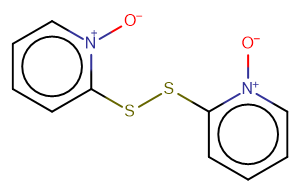
Dipyrithione
CAS No. 3696-28-4
Dipyrithione( —— )
Catalog No. M21147 CAS No. 3696-28-4
Dipyrithione appears to have novel cytotoxicity and potent broad-spectrum antitumor activity.
Purity : >98% (HPLC)
 COA
COA
 Datasheet
Datasheet
 HNMR
HNMR
 HPLC
HPLC
 MSDS
MSDS
 Handing Instructions
Handing Instructions
| Size | Price / USD | Stock | Quantity |
| 5MG | 48 | Get Quote |


|
| 10MG | 68 | Get Quote |


|
| 25MG | 115 | Get Quote |


|
| 50MG | 173 | Get Quote |


|
| 100MG | 258 | Get Quote |


|
| 200MG | 388 | Get Quote |


|
| 500MG | 642 | Get Quote |


|
| 1G | Get Quote | Get Quote |


|
Biological Information
-
Product NameDipyrithione
-
NoteResearch use only, not for human use.
-
Brief DescriptionDipyrithione appears to have novel cytotoxicity and potent broad-spectrum antitumor activity.
-
DescriptionDipyrithione appears to have novel cytotoxicity and potent broad-spectrum antitumor activity.(In Vitro):Dipyrithione (20?μg/mL) shows antifungal activity with MIC values of 6.03 μM for Trichophyton rubrum.Dipyrithione (72 h) shows cytotoxic activity against 293?T cells with an IC50 value of 0.22 μM.Dipyrithione (1-5 μM; 8.5 h) inhibits LPS (100 ng/ml)-induced up-regulation of iNOS and COX-2 in RAW264.7 cells in a dose-dependent manner.Dipyrithione (1 μM; 8.5 h) suppresses LPS-induced increase of iNOS but not COX-2 mRNA level, inhibits LPS-increased NO production.Dipyrithione (3 μM; 2, 5 h) decreases phosphorylation of STAT1 induced by LPS and does not influence LPS-induced MAPK and NF-κB activation in RAW 246.7 cells.Dipyrithione (0-5 μg/mL; 48 h) shows antiproliferative activity for KB, 231, U937 and K562 cells in a dose dependent manner.Dipyrithione (2.5 μg/ml) induces apoptosis and cycle arrest at G1 phase.(In Vivo):Dipyrithione (0.2 mg/cm2; externally once daily for 10 days) shows great anti-dermatophyte activity effects in guinea pig.Dipyrithione (1, 2.5, 5 mg/kg; i.p.) shows anti-inflammatory activity in mouse. Dipyrithione (5 mg/kg; i.p.; daily for 10 days) shows anti-tumor acyivity in mouse.
-
In VitroDipyrithione (20?μg/mL) shows antifungal activity with MIC values of 6.03 μM for Trichophyton rubrum.Dipyrithione (72 h) shows cytotoxic activity against 293?T cells with an IC50 value of 0.22 μM.Dipyrithione (1-5 μM; 8.5 h) inhibits LPS (100 ng/ml)-induced up-regulation of iNOS and COX-2 in RAW264.7 cells in a dose-dependent manner.Dipyrithione (1 μM; 8.5 h) suppresses LPS-induced increase of iNOS but not COX-2 mRNA level, inhibits LPS-increased NO production.Dipyrithione (3 μM; 2, 5 h) decreases phosphorylation of STAT1 induced by LPS and does not influence LPS-induced MAPK and NF-κB activation in RAW 246.7 cells.Dipyrithione (0-5 μg/mL; 48 h) shows antiproliferative activity for KB, 231, U937 and K562 cells in a dose dependent manner.Dipyrithione (2.5 μg/ml) induces apoptosis and cycle arrest at G1 phase. Western Blot Analysis Cell Line:RAW264.7 cells Concentration:1-5 μM Incubation Time:8.5 h Result:Inhibited the expression of LPS (100 ng/ml)-induced up-regulation of iNOS and COX-2 in a dose-dependent manner.Cell Proliferation Assay Cell Line:KB, 231, U937, K562 cellsConcentration:2.5 μg/ml Incubation Time:24 h Result:Induced cell cycle arrest at G1 phase with induced p21 accumulation, CyclinD1 and CyclinE1 expressions were downregulated.Apoptosis Analysis Cell Line:KB, 231, U937, K562 cells Concentration:2.5 μg/ml Incubation Time:36 h Result:Induced apoptosis by induced cleavage of caspase-9, caspase-3 and PARP.Western Blot Analysis Cell Line:RAW264.7 cells Concentration:1-5 μM Incubation Time:8.5 hResult:Inhibited the expression of LPS (100 ng/ml)-induced up-regulation of iNOS and COX-2 in a dose-dependent manner.
-
In VivoDipyrithione (0.2 mg/cm2; externally once daily for 10 days) shows great anti-dermatophyte activity effects in guinea pig.Dipyrithione (1, 2.5, 5 mg/kg; i.p.) shows anti-inflammatory activity in mouse.Dipyrithione (5 mg/kg; i.p.; daily for 10 days) shows anti-tumor acyivity in mouse. Animal Model:Guinea pig (infected with Trichophyton rubrum)Dosage:0.2 mg/cm2 Administration:Externally once daily for 10 days Result:Showed normal hair growth, with no scaly skin.Animal Model:18-22g male ICR mice2 Dosage:1, 2.5, 5 mg/kg Administration:I.p.Result:Raised the survival rate from 10% to 30%, 60% and 90%, respectively.Animal Model:6 weeks, 18-20 g male ICR mice (hepatoma 22 (H22) cells)Dosage:2.5 mg/kg Administration:I.p.; daily for 10 days Result:Inhibited the growth of tumor.
-
Synonyms——
-
PathwayOthers
-
TargetOther Targets
-
Recptorothers
-
Research AreaMetabolic Disease
-
Indicationdandruff
Chemical Information
-
CAS Number3696-28-4
-
Formula Weight252.32
-
Molecular FormulaC10H8N2O2S2
-
Purity>98% (HPLC)
-
SolubilityIn Vitro:?DMSO : 10 mg/mL (39.63 mM)
-
SMILES[O-][n+]1ccccc1SSc1cccc[n+]1[O-]
-
Chemical Name——
Shipping & Storage Information
-
Storage(-20℃)
-
ShippingWith Ice Pack
-
Stability≥ 2 years
Reference
1.Fan Y Liu C Huang Y et al. Dipyrithione induces cell-cycle arrest and apoptosis in four cancer cell lines in vitro and inhibits tumor growth in a mouse model[J]. BMC Pharmacology and Toxicology 2013 14(1):1-8.
molnova catalog



related products
-
Indole-3-glyoxylamid...
Indole-3-glyoxylamide (3-Indoleglyoxamide) is a marine derived natural products found in Spongosorites sp.
-
O-PHOSPHO-L-SERINE
DL-O-Phosphoserine a normal metabolite in human biofluid is an ester of serine and phosphoric acid. Serine is one of three amino acid residues that are commonly phosphorylated by kinases during cell signaling in eukaryotes.
-
Mogroside II-A2
Mogroside II-A2 is a natural product from Siraitia grosvenorii Swingle. Mogrosides exhibit antioxidant, antidiabetic and anticancer activities.



 Cart
Cart
 sales@molnova.com
sales@molnova.com


